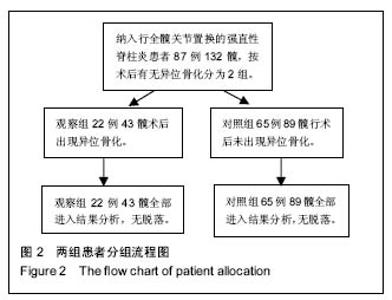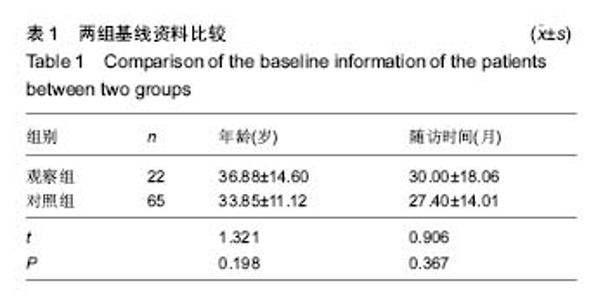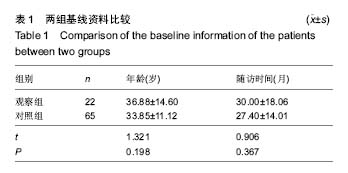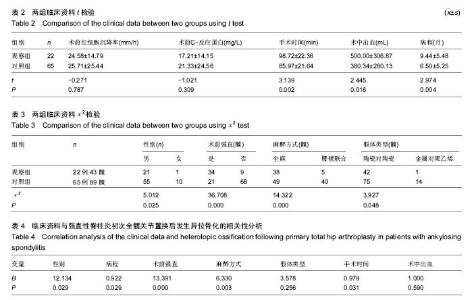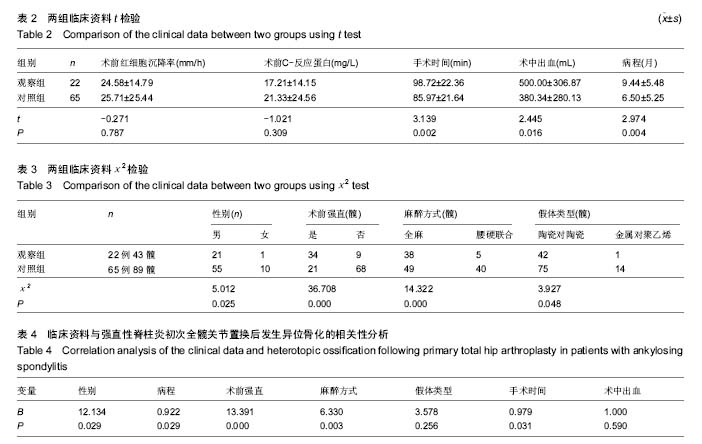| [1] Zeidler H, Calin A, Amor B. A historical perspective of the spondyloarthritis. Curr Opin Rheumatol. 2011;23(4): 327-333.[2] Jeong H, Eun YH, Kim IY, et al. Characteristics of hip involvement in patients with ankylosing spondylitis in Korea. Korean J Intern Med. 2016.[3] Goodman SM, Zhu R, Figgie MP, et al. Short-term total hip replacement outcomes in ankylosing spondylitis. J Clin Rheumatol. 2014;20(7): 363-368.[4] Brooker AF, Bowerman JW, Robinson RA, et al. Ectopic ossification following total hip replacement. Incidence and a method of classification. J Bone Joint Surg Am. 1973;55(8): 1629-1632.[5] Zhang L, Yang D, Yin X, et al. Risk factors for poor hip flexion after total hip arthroplasty for the treatment of ankylosing spondylitis a multivariate analysis. Clin Rheumatol. 2014; 33(9):1295-1301.[6] Sundaram NA, Murphy JC. Heterotopic bone formation following total hip arthroplasty in ankylosing spondylitis. Clin Orthop Relat Res. 1986;(207):223-226.[7] Corrigan CM, Greenberg SE, Sathiyakumar V, et al. Heterotopic ossification after hemiarthroplasty of the hip - A comparison of three common approaches. J Clin Orthop Trauma. 2015;6(1):1-5.[8] Winkler S, Craiovan B, Wagner F, et al. Pathogenesis and prevention strategies of heterotopic ossification in total hip arthroplasty: a narrative literature review and results of a survey in Germany. Arch Orthop Trauma Surg. 2015;135(4):481-489.[9] Lazansky MG. Complications revisited. The debit side of total hip replacement. Clin Orthop Relat Res. 1973;(95):96-103.[10] Chemaly O, Hebert-Davies J, Rouleau DM, et al. Heterotopic ossification following total hip replacement for acetabular fractures. Bone Joint J. 2013;95-B(1):95-100.[11] Chao ST, Joyce MJ, Suh JH. Treatment of heterotopic ossification. Orthopedics. 2007;30(6):457-464, 465-466.[12] Pape HC, Marsh S, Morley JR, et al. Current concepts in the development of heterotopic ossification. J Bone Joint Surg Br. 2004;86(6):783-787.[13] Healy WL, Lo TC, Covall DJ, et al. Single-dose radiation therapy for prevention of heterotopic ossification after total hip arthroplasty. J Arthroplasty. 1990;5(4):369-375.[14] Ahrengart L. Periarticular heterotopic ossification after total hip arthroplasty. Risk factors and consequences. Clin Orthop Relat Res. 1991;(263):49-58.[15] Chemaly O, Hebert-Davies J, Rouleau DM, et al. Heterotopic ossification following total hip replacement for acetabular fractures. Bone Joint J. 2013;95-B(1):95-100.[16] Ritter MA, Sieber JM. Prophylactic indomethacin for the prevention of heterotopic bone formation following total hip arthroplasty. Clin Orthop Relat Res. 1985;(196):217-225.[17] Regis D, Sandri A, Sambugaro E. Incidence of heterotopic ossification after surface and conventional total hip arthroplasty: a comparative study using anterolateral approach and indomethacin prophylaxis. Biomed Res Int. 2013;2013:293528.[18] Williams E, Taylor AR, Arden GP, et al. Arthroplasty of the hip in ankylosing spondylitis. J Bone Joint Surg Br. 1977;59-B(4): 393-397.[19] Toom A, Haviko T, Rips L. Heterotopic ossification after total hip arthroplasty. Int Orthop. 2001;24(6):323-326.[20] Thilak J, Panakkal JJ, Kim TY, et al. Risk Factors of Heterotopic Ossification Following Total Hip Arthroplasty in Patients With Ankylosing Spondylitis. J Arthroplasty. 2015; 30(12):2304-2307.[21] 高国栋.腹部手术切口感染相关危险因素研究[J].中华医院感染学杂志,2013,23(2):323-325.[22] Ruan D, Lin Z, Li Y, et al. Poor oncologic outcomes of hepatocellular carcinoma patients with intra-abdominal infection after hepatectomy. World J Gastroenterol. 2015; 21(18):5598-5606.[23] Kilgus DJ, Namba RS, Gorek JE, et al. Total hip replacement for patients who have ankylosing spondylitis. The importance of the formation of heterotopic bone and of the durability of fixation of cemented components. J Bone Joint Surg. 1990; 72(6): 834-839.[24] 李为,殷建华,王金城,等.人工全髋关节置换术后异位骨化[J]. 中华骨科杂志, 1995,15(3):152-154.[25] Hierton C, Blomgren G, Lindgren U. Factors associated with heterotopic bone formation in cemented total hip prostheses. Acta Orthop Scand. 1983;54(5):698-702.[26] Bajrektarevic D, Nistri A. Delayed application of the anesthetic propofol contrasts the neurotoxic effects of kainate on rat organotypic spinal slice cultures. Neurotoxicology. 2016;54: 1-10.[27] Reznik JE, Biros E, Milanese S, et al. Prevalence of neurogenic heterotopic ossification in traumatic head- and spinal-injured patients admitted to a tertiary referral hospital in Australia. Health Care Manag (Frederick). 2015;34(1):54-61.[28] Kaplan FS, Glaser DL, Hebela N, et al. Heterotopic ossification. J Am Acad Orthop Surg. 2004;12(2):116-125.[29] Tani Y, Nishioka J, Inoue K, et al. Relation between ectopic ossification after total hip arthroplasty and activity of general inflammation in patients with ankylosing spondylitis. Ann Rheum Dis. 1998;57(10):634.[30] Hermann KA, Bollow M. Magnetic Resonance Imaging of Sacroiliitis in Patients with Spondyloarthritis: Correlation with Anatomy and Histology. Rofo. 2014;186(3):230-237.[31] Baraliakos X, Haibel H, Listing J, et al. Continuous long-term anti-TNF therapy does not lead to an increase in the rate of new bone formation over 8 years in patients with ankylosing spondylitis. Ann Rheum Dis. 2014, 73(4):710-715.[32] van Duivenvoorde LM, Ambarus CA, Masdar H, et al. Relative overexpression of transmembrane versus soluble tnf in human and experimental spondyloarthritis. Ann Rheum Dis. 2013;721: A9-A10.[33] Weiss PF. Diagnosis and treatment of enthesitis-related arthritis. Adoles Health. 2012;2012(3):67-74.[34] Chang J, Liu F, Lee M, et al. NF-kappa B inhibits osteogenic differentiation of mesenchymal stem cells by promoting beta-catenin degradation. Proc Natl Acad Sci U S A. 2013; 110(23):9469-9474.[35] Maloney WJ, Krushell RJ, Jasty M, et al. Incidence of heterotopic ossification after total hip replacement: effect of the type of fixation of the femoral component. J Bone Joint Surg Am. 1991;73(2):191-193.[36] Lieberman IH, Moran E, Hastings DE, et al. Heterotopic ossification after primary cemented and noncemented total hip arthroplasty in patients with osteoarthritis and rheumatoid arthritis. Can J Surg. 1994;37(2):135-139.[37] Duck HJ, Mylod AG. Heterotopic bone in hip arthroplasties. Cemented versus noncemented. Clin Orthop Relat Res. 1992;(282):145-153.[38] Wixson RL, Stulberg SD, Mehlhoff M. Total hip replacement with cemented, uncemented, and hybrid prostheses. A comparison of clinical and radiographic results at two to four years. J Bone Joint Surg. 1991;73(2):257-270. |
